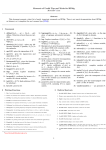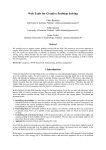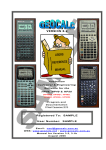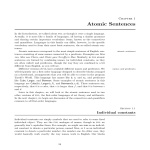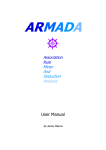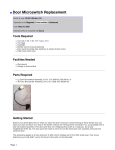Download Freshman Projects The Hard Way (A La Goldberg)
Transcript
Session 2553 Freshman Projects the Hard Way (a la Goldberg) William Park Clemson University ABSTRACT Design and construction of devices in the style of Rube Goldberg is being used as the primary motivational structure for teaching engineering design and teamwork to freshmen. The early trials began with each team of nominally four students designing a device to perform a simple function (e.g. crushing an aluminum can). This has evolved to projects involving two four member teams working together to implement a pair of devices which must interact to accomplish the overall goal. For example, the most recent semester’s project was a coin-operated vending machine. One team’s device had to accept a coin, verify that it is a quarter, then activate the other team’s machine. When activated, the other group’s device must deliver one of three products as selected by the user. The inter-group communications required to resolve common issues provides an extra dimension in team building skills. Many requirements and restrictions are specified for the projects and involve parameters such as maximum cost, size, and weight; minimum number of separate operations performed to accomplish the task (Goldberg’s approach); minimum and maximum amount of time allowed for the device to perform the task; and safety factors as well as numerous others. Final oral and written reports must be presented, including both a User’s Manual, and a Technical Report. The Technical Report includes mathematical analyses of the various parts of the machines as well as fabrication procedures and a cost analysis. An informal (though graded) preliminary demonstration is held about two weeks before the official public demonstration to which the general public is invited. INTRODUCTION Three years ago, the freshman engineering curriculum at Clemson University was completely overhauled. Replacing the standard freshman programming course (FORTRAN) during the second semester was ENGR 120, a new course in engineering computation, problem solving and design. A group project was designated to be an integral part of this new course. With about a dozen professors from eight different departments teaching the course, the implementation of the project and its integration into the course content has varied considerably from section to section. This paper documents my choices and progress toward this goal. Page 3.295.1 When I try to recall my own freshman experience from the mists of antiquity, one thing stands out in stark relief to all else - the required freshman project. My memories of most of the required freshman course work is rather blurry and dreary, but the project stands out as the high point of the year. It motivated me, it involved me, and most importantly it made me think. With this in mind, I decided to make the project the centerpiece of my version of ENGR 120. THE PROJECT Recalling a suggestion concerning Rube Goldberg style devices I heard some years ago at an ASEE conference, the project I assigned the first semester was to build a device to crush a standard aluminum soda can using a minimum of five steps and at least twenty seconds. Much was learned from the first trial, and through subsequent semesters, most of the problems have been resolved. Since I have found that many students are not familiar with the work of Rube Goldberg, I describe a typical Goldberg mousetrap, a diagram of which most students have seen before. In addition to this explanation, I show a couple of brief excerpts from popular movies, such as “The Goonies” and “Pee Wee’s Big Adventure”, which contain such devices. The children’s game “Mousetrap” could also be set up and demonstrated, although I have not done this. Following the introduction, I discuss the basic rules/specifications of the project. These rules concern function, safety, cost, and grading as well as various restrictions on size, speed, weight, etc. It has taken several iterations to develop a set of rules which specify the functions of the project with little ambiguity, provide suitable challenge without narrowing the options excessively, prevent any teams with specific skills from having an undue advantage, and maintain an acceptable safety margin. (I learned this during the first trial of the new course when one team had two concrete blocks perched about three feet off the ground with questionable stability. Fortunately, I recognized the danger when I first saw the machine set up and warned everyone to stand well away from the device. The blocks did indeed come crashing down on the third trial.) The projects (with some repetitions) have been an aluminum can crusher, a coin bank, and most recently a coin operated vending machine. I will focus on the latter project, since most of the rules can directly, or with minor modification, suit any project of this nature. Of course, specifications for completely different types of functions would have to be written for the specific case. For the coin-operated vending machine, the functions were divided into two sections with two four-member teams working together to develop the overall device. One team designed and built the coin-handling section, which had to accept a standard US Quarter as valid and return any other modern US coin to the user. (The one exception is the poorly engineered and short-lived Susan B. Anthony Dollar, which is almost identical to a quarter.) When a quarter was inserted, it had to be passed to the Product Delivery section, which would then deliver to the user one of three selected products, or return the quarter if no product had been selected. Page 3.295.2 Perhaps the best way to explain this more completely is to give an example of the rules that were used for this project. These rules have varied somewhat over the semesters, but most of them are now fairly stable. One exception is the rule concerning the use of fire. Prior to this semester, I have allowed the use of fire as long as the flame was no larger than that of a standard candle and appropriate safety precautions were observed. I will allow use of fire again in the future as it adds a variety of interesting options. Also, I usually require five steps rather than four, but decided to lower this for the first trial of the dual team format. I will increase this to five steps for next semester’s projects. RULES General Rules There are many details here. Failure to meet specifications will result in lost points on your final project grade. These rules are in no particular order, and may be modified or augmented by the professor as unanticipated questions or situations arise. Page 3.295.3 Each pair of teams will coordinate efforts to design, construct, and demonstrate a coin-operated vending machine which will meet the specifications below. One team of each pair will be responsible for the coin handling mechanism, and the other will have the task of implementing the product delivery system. Each of the two sections of the vending machine is to be built in the style of Rube Goldberg, and each must meet the following criteria: • There must be a minimum of four (4) separate sequential steps. Each of the four steps must be fundamentally different from the others in some way and each must be necessary to the overall function, i.e. accepting the coin and activating the delivery system for one section and delivering the product in the other. Bonus points will be awarded for devices utilizing more than four steps. The professor is the final judge of what constitutes a separate “step”. • The cost of all materials, including found or scavenged materials, must be accounted for. The maximum cost for all parts used in each device is $60.00. • No animals are allowed in the device. • No explosives, firearms, fire, etc. are allowed in the device. • No excessively dangerous devices of any form are allowed. If there are any questions concerning this rule, ask the professor. (He will be the final judge of the acceptability of any specific scheme.) • The device must be designed to eliminate the possibility of someone being inadvertently injured by the device. • Each device must fit within a rectangular box with a volume of less than one cubic yard, and no individual dimension of the box may exceed four feet. (For example a 4' X 3' X 2' device is OK, but a 5' X 2' X 2' device is not acceptable.) No part of either device may at any time during its operation go beyond these limits, with the one exception mentioned below. Although your device should fit in the specified box, you must not enclose your device in a box. All mechanisms involved must be clearly visible to those observing the operation of your device. • There must not be any device using a voltage greater than 12 Volts, and all electrical devices must be powered by DC. In other words, you may not plug it into a wall socket. • The device must have a set-up time of less than 10 minutes. The setup time includes any adjustments necessary to store any energy needed for operation of the device. • Each device must have a minimum delay of at least 25 seconds between the time it is activated and the time it completes its task. The maximum delay must be less than 3 minutes. One team of a pair may not trade delay time with their partner team (e.g. the coin handling device cannot use 55 seconds and the product delivery device only use 20 seconds). • Computer or electronic (semiconductor devices) control is not allowed. • The device must not make a mess. For example, it may not spill water or sand on the floor. • The device and all its parts must weigh less than 40 pounds. Specifications for the Coin Handling Module • The location in your device where the coin is inserted will be called the insertion point. To start, the coin may inserted into the device at the insertion point in any way you wish as long as it is not thrown or otherwise given any kinetic energy by the person placing the coin. • The device may be activated either by the action of placing the coin in the device, or by activating a separate switch, lever, button, etc. after the coin is placed at the insertion point. You may not, however, add any significant amount of energy to the system during or after the insertion of the coin. (For example, you may not pull on a string which lifts the coin itself or any part of your mechanism.) In other words, all of the energy required must be stored in the device before the coin is inserted. (See setup time mentioned in Basic Rules above.) • The coin handler must be able to distinguish a quarter from other standard US coinage (1¢, 5¢, 10¢, & 50¢). Only a 25¢ coin should result in activation of the product delivery mechanism. Any other coin should be returned to the user in a coin return tray located near the insertion point and made easily accessible to the user. • After the coin is placed and the machine is activated, you may not assist its actions in any way. The entire process of deciding if the coin is a quarter and either returning it or activating the product delivery module must proceed on its own. • If a quarter is inserted, it must be passed to the product delivery section. However, the two sections (coin handling and product delivery) must not touch or be connected in any way when they are in operating position. (See next rule.) • You should be able to slide a solid piece of cardboard between your section (coin handling) and the other section (product delivery) when they are in their final operating positions. The only exception to this is that your device (coin handling) may extend a rod, etc. over to touch and activate the product delivery module, though this is not necessary. • During its journey from the insertion point to wherever it exits your device and enters the product handler, the coin must travel a minimum total distance of three feet (not necessarily in a straight line) and it must have at least two distinct discontinuities (abrupt changes) in its path. Page 3.295.4 Specifications for the Product Delivery Module • The product delivery module must make provisions for the user to select one of three products. You may choose the products you wish to include subject to the following restrictions: 1. No glass containers or other products which might be easily broken. 2. No products that might be dangerous or illegal. 3. The products should be available commercially for less than one dollar (I'll give you a little more flexibility than restricting you to 25¢). 4. No condoms or other products which might cause controversy or embarrassment to some people or the university. It is possible that these devices will be in local papers and on local TV news shows. • • • • • • 5. You must get the professor's approval for all products no later than Oct. 15. Any later changes are discouraged and must be approved by the professor. The selection mechanism may be a set of levers, buttons, etc. but all products should be delivered to a common delivery location near the selection mechanism. The products must be stored a minimum of 18 inches from the delivery location and at least 6 inches below the delivery location. Each product must travel a minimum of three feet from the storage location to the delivery location and have at least one discontinuity (abrupt change) in its path. You may resupply the device after each trial. In other words, you do not have to stock multiples of each product in the device. Your device must accept the quarter from the coin handling module. If the user failed to make a selection before inserting the coin, the quarter must be returned to the user in the product delivery location. You may not have a default product choice to get out of this requirement. Naturally, if a selection is made, the quarter should not be returned to the user. You may not interfere with the device in any way after a selection is made and a coin inserted. It is on its own. The product delivery system must automatically reset the selection mechanism back to “no selection” during the process of delivering the product. LOGISTICS There are several logistical issues which have to be resolved to implement the project. First, all project specifications are placed on my web site so that students have easy access to them. This also greatly simplifies any necessary updating of the rules. Teams Usually, the teams function smoothly, and most students pull their weight within the team. There is almost always one team. however, with some form of difficulty. Over the past several semesters, I have developed the following method of assigning teams to minimize problems. TEAM SIZE Whenever possible, I try to establish teams with four students each. Five student teams usually do not function as smoothly and at least one person is almost always hanging on the coattails of the others. From the standpoint of individual participation within the team, I would prefer three students per group, but have found by experience that this is a recipe for disaster. At the freshman level, it is not uncommon to have students who are at college to party hard for a year and then flunk out. These students contribute absolutely nothing to the group. During the second iteration of the course, I had set up groups of three. In one of the groups, two of the members did absolutely nothing and the remaining member had no practical construction skills. She ended up attempting to construct her project by herself and it was difficult to fairly assess her performance in this situation. Since then, I have always assigned groups of four whenever possible, and this has worked well. Twice since then, I have had groups where two members contributed nothing, but there was still a team left, albeit with only two members. Page 3.295.5 TEAM SELECTION Having tried various methods for selecting teams, I have finally settled on the following general plan. This is a two step process. Since these projects are rather difficult and time consuming, I like to start work on them as soon as possible. However, I wait until after the first major test is given early in the semester. Following the first test, I sort the students in descending order by their averages (including homework, in-class assignments, and short quizzes as well as the major test). After determining how many groups there will be (typically eight in a section of 32 students), I simply go down the list, placing one of the highest eight (or however many groups there are) on each student team, then repeat by groups of eight according to averages. The intent is to make sure there is at least one good student, two adequate students, and hopefully no more than one questionable student on each team. Early in the semester, I have students complete a brief survey to evaluate whether they have access to basic hand tools and how much experience they have actually building things. I then compare my list based on grades with the results of the survey to assure that each team has access to basic tools (more on this later) and has at least one person with some facility using them. I then swap team members between groups as necessary, maintaining the relative “quality” by swapping students from the same general grade level. This process usually only takes about ten minutes to determine a set of properly balanced teams. In the past, I have tried matching teams to assure that no team has a single member of a minority group or a single female, but have found this not to be an issue. Only twice in the past three years have I had any indication that race or gender was an impediment to team functions, and these were not serious. To avoid the problem of “I forgot what group I’m in” I create a web page containing all team assignments, indexed both by student name and by team, and require finding their team assignment and group members as homework. If needed, they know how to find this information again. Tools During the spring semester, over 500 students are enrolled in ENGR 120. Unfortunately, we do not yet have the resources to provide a shop with basic tools for this number of students. There have been times when I have provided my own personal tools as “loaners” to students. Since I have implemented the simple survey on tool access and use, this has not been necessary. The lack of fancy fabrication tools does limit the students’ options, but this has not proven to be a serious impediment to project implementation. Page 3.295.6 Time Perhaps a more important issue is time. This involves two issues: total time needed to design, construct and debug the project; and finding times when all group members can meet. The latter problem is especially difficult for commuting students and for part-time students who work essentially full-time. The highest student estimate I have heard for time spent working on the project is 100 hours, but I believe 30 to 40 hours is more typical. Within the context of one semester, this is quite a lot of extra time, so I make a point of releasing class time on a regular basis for project work. The course is set up as a one-hour lecture and two two-hour labs per week. During the last two-thirds of the semester, I usually release one of the lab periods every other week for project work. This not only frees up some of the class time for the project, but also facilitates meeting as a complete group for those who have difficulties. DEMONSTRATIONS Two to three weeks before the final public demonstrations of the projects, the students must have a preliminary demonstration. This requirement not only forces students to complete the work on time, but it also forces them to realize that their devices do not function according to specifications (seldom are all criteria met at the preliminary demo). Since instituting the preliminary demos, the success rate of the projects has more or less doubled. It is now typical for over half of the teams to meet all criteria and for most of the others to have a functional machine that does not quite meet all specifications. Each team must give an oral report to the class during the preliminary demonstration. The final demonstrations are held in the atrium of one of the main engineering buildings and are on display for anyone who wishes to come by. This gives students a chance to explain their machines individually in a somewhat less formal setting than the oral report. Half of the project grade is based on the final demonstration. Further details on assessment for grading are given below. GRADING The project grade is usually 20% of the final course grade. Project grading is based on numerous factors, and anyone attempting to implement a similar project will have to determine a scheme that works for them. I will however, briefly outline my own grading method. Demonstrations The preliminary demonstration is typically 10% of the final project grade. I am not particularly strict about grading of the preliminary demo unless it is obvious that a totally insufficient effort has been put forth. If the device doesn’t work up to specs or isn’t quite complete, I deduct a point or two (out of ten). This is the usual case. For the final demonstration, the device must officially perform its function three or four times. (Students will usually demonstrate their machine many more times as people drop by to view them.) It is helpful to make a grading form beforehand with the various criteria listed on the form. During the chaos of the demonstrations, it is relatively easy to forget to check one or more of the specifications. The following is a partial list of grading criteria for the vending machine project. Page 3.295.7 • During the demonstrations, you will have to operate the machine four times with four quarters. For each failure of the machine to deliver a product, the penalties shown in Table 1 will be assigned to the group responsible for the failure. If the coin handling fails, the product delivery section will be triggered manually to verify its function. Table 1 Number of Failures 1 2 3 4 Points Deducted 2 5 9 14 • The vending machine will also be tested with a penny, a nickel, dime, and a half-dollar. In each case, the coin must be returned to the user as indicated in the rules for the individual devices. A three point penalty will be assessed to the coin handling group for each failure to return an incorrect coin. • If the machine delivers a product, but it is the wrong one, the product delivery group will be assessed a three point penalty for each incorrect product delivered. • Two bonus points will be awarded if the device incorporates at least one small DC motor (12 Volt maximum). In addition to the basic function of the device, points are deducted for failure to meet specifications, such as size, set-up time, time constraints on operation, etc. Written Reports The written reports must have a cover page, a User’s Guide, a Technical Summary, a parts list and cost accounting, diagrams as necessary, and Conclusions/Possible Improvements. The Cover Page must include each group member’s name, and each member must initial the report by their name. This indicates that they have read and approved the contents of the report. If for some reason they are not satisfied with the report and it is beyond their power to get it modified, they are instructed to speak to me privately about their concerns. I have not yet had any student come to me in this regard. I tell the students that if all of the grandmothers of all of the team members can set up and operate the machine by reading the User’s Guide, then they have succeeded with this section of the written report. Despite this guideline, I still get some groups who are penalized for using techno-babble in the User’s Guide. Page 3.295.8 The Technical Summary must include an overview of the construction of the device, the basic operational principles, and mathematical analyses of the various machines composing the overall Rube Goldberg style device. This should be supported by pictures or diagrams as necessary. Since we do not teach technical drawing of any form in or prior to this course, the quality of the drawings varies considerably, and I am quite lenient in grading diagrams. Because a large portion of the course involves mathematical analysis of physical systems, more attention is directed to this aspect of the Technical Summary. More details on the Technical Summary are found in the section on Course Integration. Individual critiques Each team member must write a confidential evaluation of each of the other members of the team. In the evaluation, the contributions of each member (other than themselves) are to be briefly discussed, including any failure to meet obligations within the group. Each team member should be assigned a letter grade using + or - as appropriate. As mentioned earlier, most teams work well together, and typically most students grade their team members with an A or B. However, students are quite honest when a team member does not contribute their fair share to the project. I always have a few students who are given C’s, D’s, or F’s by their team members. When all members are unanimous in assigning a grade, I reduce the subject student’s grade by an amount that will yield the next higher letter grade if everything else is perfect, which essentially never happens. For example, if all members rate a student as a D, I deduct 30 points from their project grade, giving that student a low C if he gets full credit for everything else. COURSE INTEGRATION In addition to teaching basic computational skills utilizing a calculator (HP48G), a spreadsheet (EXCEL), and a basic mathematics package (MATLAB), the course includes estimation, graphical presentation and analysis of data, basic applied physics, and problem solving methodology. The latter is supported by Fogler and LeBlanc’s text Strategies for Creative Problem Solving.1 I have experimented with different degrees of integration of the problem solving methods presented in this text with the project and have met with mixed results. My general experience has been that students perform better if the “structured creativity” (seemingly an oxymoron) is not forced on them more than minimally. I always make two or three assignments that apply techniques from the book to the project, but I also give the students a choice. For example, several brainstorming techniques are discussed with the teams having to choose any two techniques for application to their project. The integration of the project with the topics of estimation, graphical analysis/presentation of data, calculator usage, and applied physics is more extensive. Examples from previous projects are used for presentation of principles by the professor, for in-class solution by informal groups of two or three students, for homework, and for test questions. The students are also expected to analyze the various individual mechanisms which they have incorporated into their machines as part of the Technical Summary of the final written report. A few examples should suffice to convey the general idea. Page 3.295.9 The students could be asked to estimate how long would be required for a two liter soda bottle full of water (or sand, or ?) to be emptied through a 3mm hole in the bottom (a common tactic for providing a time delay). This could also be set up experimentally, having the students record water levels versus time, then represent and analyze this data graphically. Students can then check the mathematical model thus determined by using the curve fitting routines in the HP48G. Most projects utilize at least one lever, which leads directly to an analysis of the forces on the lever. Many roll a ball down a ramp, thus leading to a calculation of the time required for the ball to complete its journey and, when coupled with experimental trials, an estimate of friction in the system. If a small electric motor is used to operate an elevator to lift a weight, the horsepower of the motor can be calculated. Other types of devices commonly used and subject to analysis are conveyor belts, catapults, lines of falling dominoes (they usually find this analysis to be somewhat interesting), and the list goes on and on. Analyzing devices in class that may be directly related to the projects runs the risk that students will automatically use the examples in their projects. For this reason, I delay analyzing specific project examples until construction is well under way, making it less feasible for students to modify their plans. The earlier part of the course is used for general principles and techniques, and more generic examples are utilized CONCLUSIONS Each semester I learn a few more things, and modify the rules and conditions accordingly. For example, the rule (introduced just last semester) concerning making a mess with sand or water was evidently interpreted to mean these should not be used - this was the first time no team used water or sand as a method of providing a time delay. That rule will be rewritten in the future. One major advantage of this approach is the enthusiasm of the students. They become more interested in these projects than any other type I have ever assigned to freshmen. Students almost unanimously rate the project as the most enjoyable part of the course despite the amount of effort required. An unanticipated bonus has been the interest of the news media which has given both our academic program and engineering in general considerable coverage in both newspapers and television news reports. BIBLIOGRAPHY 1. Fogler, H. S. and LeBlanc, S. E., Strategies for Creative Problem Solving, Prentice-Hall, Upper Saddle River, NJ, 1995 WILLIAM PARK BS (78), Ornamental Horticulture. MS (81), PhD (86), Electrical Engineering, specializing in electronic music synthesis and coding theory respectively. Currently teaches in both Freshman and Electrical Engineering, as well as being actively involved in student recruiting. Interests include fractal geometry, experimental musical instruments, taijiquan, Chinese language studies, and xerophytic horticulture. Page 3.295.10










